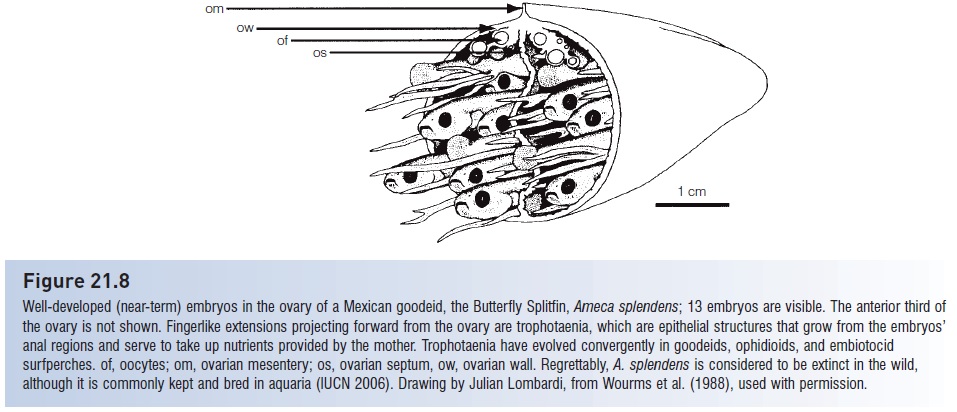Chapter: The Diversity of Fishes: Biology, Evolution, and Ecology: Teleosts at last II:spiny-rayed fishes
Series Atherinomorpha

Series Atherinomorpha
The most successful fishes at the surface layer of the ocean and of many freshwater habitats are in the three orders of the Atherinomorpha. Such well-known surface dwellers as silver sides, needle fishes, sauries, flying fishes, halfbeaks, killifishes, topminnows, and livebearers all belong to thisgroup (Fig. 15.4). Anatomically, the atherinomorphs are setaside from the rest of the acanthopterygians in part becausethey have a unique way of protruding the jaw. The premaxilladoes not articulate directly with the maxilla. Protrusioninstead occurs by an intervening linkage between premaxillaand maxilla via the rostral cartilage. Atherinomorphs typically have terminal or superior mouths, as would beexpected of surface-feeding fishes. Internal fertilization and

Figure 15.4
Atherinimorphs. (A) A belonid needlefish, Tylosurus crocodilus. (B) A fundulid Striped Killifish, Fundulus majalis, showing the male above,and female below. (C) The Four-eyed Fish, Anableps. (A) from Collette(1995), used with permission; (B) drawing by H. L. Todd, in Colletteand Klein-MacPhee (2002); (C) from Jordan (1905).
Within the order Atheriniformes are six families of generally small, silvery fishes. The atherinopsid New World silver sides are widespread freshwater and marine fishes that normally occur in schools in shallow water. Atherinopsids include the grunions (Leuresthes spp.) of southern and Baja California, which ride waves up beaches to spawn in wets and every 2 weeks during the summer (see Semilunar and lunar patterns). Sexual determination isunder environmental control in some species, best studied in the Atlantic Silverside, Menidia menidia. A radiation of 18 atherinopsid species, including apparent piscivorous species, has developed in lakes of the Mexican plateau. The melanotaeniid rainbow fishes of Australia and New Guinea are strongly sexually dimorphic freshwater fishes. Males have brighter colors and longer fins than females, traits that make them popularaquarium species. Such pronounced sexual dimorphism israre in more primitive groups outside of the breeding season, except in some deepsea fishes. The small (<4 cm)phallostethids are peculiar Southeast Asian atheriniforms in which the pelvic girdle and other structures of the malesare modified into a complex clasping and intromittentorgan for holding onto females and fertilizing their eggsinternally. Females lack a pelvic girdle; they are also unusualin that they lay fertilized eggs rather than having young develop internally, which is the more normal course for fishes with internal fertilization.
Beloniforms are predominantly silvery, marine fishes active at and sometimes above the surface of the water. The adrianichthyidsinclude the medakas or ricefishes, Oryzias,that are used extensively in genetic, embryological, and physiological investigations. The suborder Belonoidei containsspecies with a number of anatomical features that show precursors and intermediate conditions during theevolution of rather specialized traits. The lower lobe of the caudal fin in primitive beloniforms has more principle raysthan the upper lobe. A rounded or square tail in primitive groups has changed into a forked tail fin with a slightly elongate lower lobe in thebelonid needlefishes, species which periodically leave the water in short, arcing leaps(Fig. 15.4A). The lower lobe is very pronounced in theexocoetid flyingfishes, which use it as a sculling organ toaccelerate during take-offs and to extend their glidingflights that can last hundreds of meters (Davenport 1994; Evading pursuit). A tendency for elongationof the lower or both jaws occurs in all belonoid groups,
expressed as a garlike prey capture structure in piscivorous needlefishes and as unequal jaw lengths in sauries and particularlyin halfbeaks. During development, different families show different developmental rates for the two jaws before the adult condition is reached, suggesting that evolution within the group has involved alterations in developmental rate of the jaws (=“heterochrony”) (Boughton et al.1991; Evolution via adjustments in development:heterochrony, paedomorphosis, and neoteny). For example, the lower jaw of some juvenile needlefishes is atfirst longer than the upper jaw, which later catches up. Insome fl ying fishes, the lower jaw is at first elongated butlater in life both jaws are essentially equal in length andneither projects forward. Halfbeaks, despite their predatoryappearance, use their elongate lower jaw to feed on floatingpieces of seagrasses; some freshwater species take insects atthe water surface. Their herbivory is even more notablegiven that hemiramphids lack a true stomach, grinding upplant material in a pharyngeal mill.
The cyprinodontiforms are a major group of freshwater fishes, many of which show a high tolerance for saline and even hypersaline conditions (see Deserts and other seasonally arid environments). They are largelysurface swimmers, preying on insects that fall into thewater, which they detect using lateral line pores on theupper surface of the head. Life history traits in different cyprinodontiform families take on extreme conditions.Some of the South American and African aplocheilid andnothobranchiid rivulines are annual fishes that live in temporaryhabitats, spawn during the rainy season and die,their genes preserved in eggs that lie in a resting state inbottom muds until the next rains; the eggs are suffi ciently drought resistant to survive for over 1 year. Kryptolebias (formerlyRivulus) marmoratus of southFlorida and the West Indies is the only fish species knownto be self-fertilizing. Sexual dimorphism reaches extremesin the elongate, brightly colored median fins of male rivulines(e.g., lyretails, panchax), poeciliids (sailfin mollies,guppies, swordtails), and pupfishes. Some goodeids have aplacentalike connection between the mother and the internallydeveloping young (see Parental care andFig. 21.8).

Related Topics